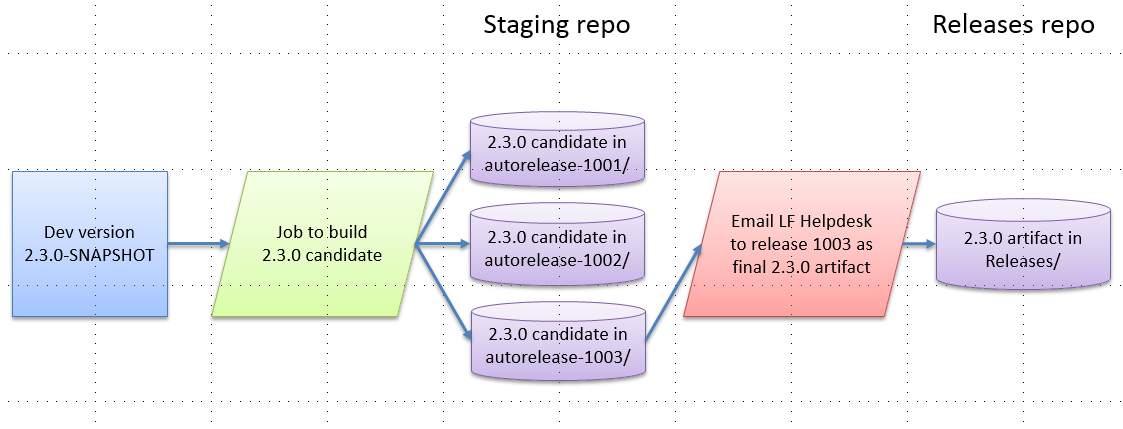Overview
- No cross-project SNAPSHOT dependencies
- Teams to version and release their own artifacts on their own schedule
- Version numbers should conform to the Semantic Versioning 2.0.0 Specification
- ONAP community "simultaneous release" is composed of a collection of artifact versions defined in a "version manifest" in source control
- Teams to declare and update the “correct version” for cross-project use and for inclusion in simultaneous release
- Manifests located in integration repo: https://git.onap.org/integration/tree/version-manifest/src/main/resources
- TSC to approve version manifest for simultaneous release, e.g. Amsterdam
- ONAP Version Manifest Maven Plugin to check against outdated dependencies vs. the manifest
- Teams to version bump their dependencies per their convenience
Benefits
- No unexpected build failures due to upstream SNAPSHOT changes
- No need for cross-project consolidated “mega builds” to check dependency issues
- Avoids issues with trying to synchronize artifact version numbers across projects
- Improved dev and build cycle time
Rationale
Details on the history and discussions that led to this process can be found at Release Versioning Strategy.
Roll-out Schedule
- Due to potential cascading dependencies, and the fact that some teams may not be ready to formally release artifacts before M4 Code Freeze, we expect some teams to need more time to be able to remove all their SNAPSHOT dependencies.
- Ideally, by RC0 all project teams should have already formally released at least one version of their artifacts. So by this time we should be able to start enforcing the no SNAPSHOTs requirement.
Java (Maven) Artifacts Release Process
- Ensure that your artifacts inherit from O-Parent (oparent)
- If not possible, please maintain your own implementations of the various configurations and checks provided by oparent
- Remove all external SNAPSHOT dependencies
- External = cross-project (including oparent) or 3rd party
- Check version manifest at https://git.onap.org/integration/tree/version-manifest/src/main/resources for the right version to use for your cross-project dependencies
The Integration team is providing a Maven plugin to warn you of outdated references: ONAP Version Manifest Maven Plugin. To use it, run the following command:
mvn org.onap.integration:version-manifest:version-check
- If your upstream cross-project dependencies haven't entered their artifacts in the manifest above, please contact the respective project team to get them to version/release their artifacts and add their entries to the manifest
- Remove ecomp-staging Nexus repo from your local ~/.m2/settings.xml repositories list; all release-versioned artifact dependencies should be fulfilled from the ecomp-releases repo only going forward
- Set up -release-version jobs (staging jobs) to deploy candidate artifacts to Staging
- Generates candidate “autorelease-xxxx” directories in Nexus
- Ensure that your version.properties file has the right version number defined for the intended release
- Ensure that the staging jobs above have completed and generated candidate artifacts
- Perform any necessary testing against the candidate artifacts
- Email helpdesk@onap.org to select a candidate as formal release artifact
- Specify the specific Jenkins build job that generated the selected candidate build, e.g. https://jenkins.onap.org/view/oparent/job/oparent-master-release-version-java-daily/16/
- LF will GPG sign and release the artifacts to Releases repo
- LF will place a GPG signed tag on the specific commit in Gerrit repo
- Update the declared version numbers for your respective artifacts in the java version manifest: https://git.onap.org/integration/tree/version-manifest/src/main/resources/java-manifest.csv
- Update the CHANGELOG to described the changes that were part of this release
- TBD: CHANGELOG structure and update process is being developed by the Documentation project
- Bump your own version numbers for ongoing development
- SNAPSHOT versions in pom.xml
- Staging/Release version in version.properties
Docker Images Release Process
Prepare your docker images. Here is the high level flow relating the various Java artifact versions to Docker tags:
- Produce SNAPSHOT Java artifact. Test this in a SNAPSHOT docker image.
- Produce staging (release candidate) Java artifact. Test this in a SNAPSHOT docker image.
- Produce release Java artifact by picking one of the candidates from staging.
- Produce STAGING docker image using the release Java artifact. Use this in E2E test flows.
- Produce RELEASE docker image by picking one of the candidate STAGING docker images.
Docker image release process:
- Set up docker staging jobs to produce the STAGING docker images.
- Ensure that the docker staging jobs have completed and generated candidate artifacts
- Perform any necessary testing against the candidate artifacts
- Email helpdesk@onap.org to select a candidate as formal release artifact
- Specify the specific Jenkins build job that generated the selected candidate build, e.g. https://jenkins.onap.org/view/oparent/job/oparent-master-release-version-java-daily/16/
- LF to re-tag the selected STAGING docker image with a RELEASE version tag
- Update the declared version number for your docker image in the docker version manifest: https://git.onap.org/integration/tree/version-manifest/src/main/resources/docker-manifest.csv
- Update the CHANGELOG to described the changes that were part of this release
- TBD: CHANGELOG structure and update process is being developed by the Documentation project
- Bump your own version numbers for ongoing development
- Staging/Release version in version.properties
